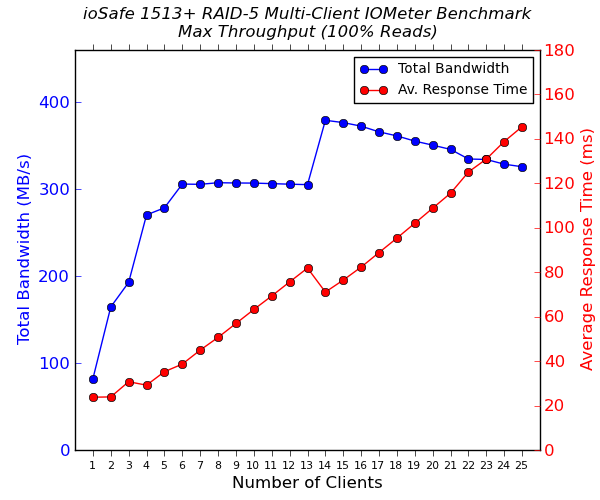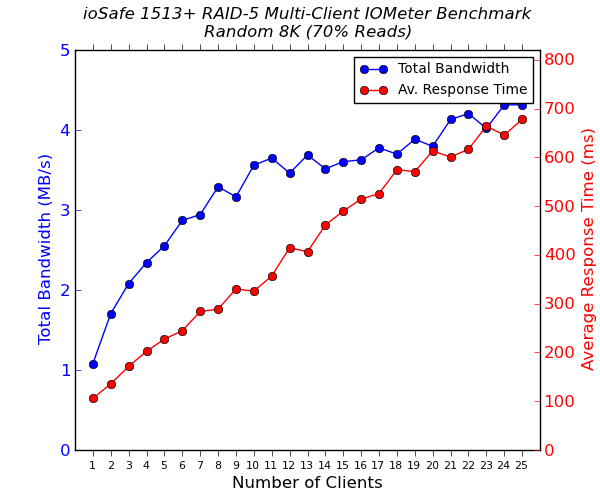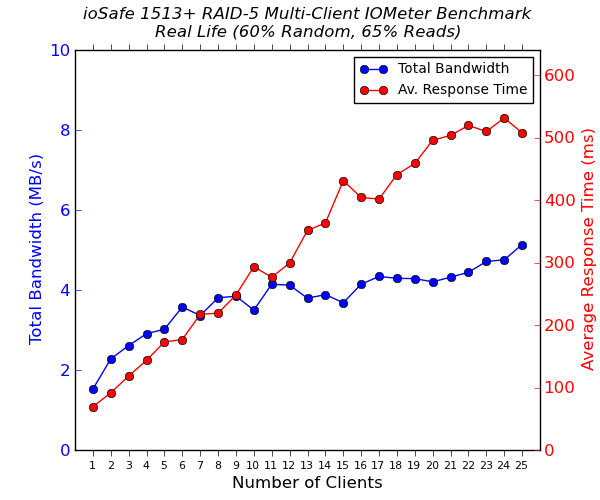ioSafe 1513+ Review: A Disaster-Resistant Synology DS1513+
by Ganesh T S on August 13, 2014 7:30 AM EST- Posted in
- NAS
- Storage
- Synology
- Enterprise
- ioSafe
Multi-Client Performance - CIFS
We put the ioSafe1513+ through some IOMeter tests with a CIFS share being accessed from up to 25 VMs simultaneously. The following four graphs show the total available bandwidth and the average response time while being subject to different types of workloads through IOMeter. The tool also reports various other metrics of interest such as maximum response time, read and write IOPS, separate read and write bandwidth figures etc. Some of the interesting aspects from our IOMeter benchmarking run can be found here. The only other device in the graphs below is the LaCie 5big NAS Pro, but note that any direct comparison is rendered moot by the presence of only two network links in that device compared to four in the ioSafe 1513+.




Beyond 12 or so clients, the performance for sequential workloads saturates. However, the powerful nature of the platform is exposed by the fact that even with 25 clients simultaneously stressing the NAS, the response times remains excellent. In addition, the bandwidth numbers for random workloads don't show any signs of degradation even with all clients simultaneously active.










43 Comments
View All Comments
bkleven - Friday, August 15, 2014 - link
Most modern safes have a small hole in the back for cabling, which is usually intended to bring electricity into the safe to power humidity control equipment (and that is usually just a heater). When you are forced to place a safe in a location that is not climate controlled it's pretty important to prevent condensation from occurring anywhere inside.I've never looked into the impact that hole has on fire protection (I presume there is some impact) but obviously flooding is an issue unless you spay foam it or use some sort of grommet.
bsd228 - Monday, August 18, 2014 - link
Cannon, for example, provides power and a cat 5 connection on most of their safes. It's not a problem.Beany2013 - Saturday, August 16, 2014 - link
I doubt the floor of my flat is rated to half a ton of spot weight. Nor that of most SOHO offices in houses or houses converted to office buildings (as with a lot of small town businesses).It's a pretty practical solution, though, I'll grant you, if your floor is rated for it.
robb.moore - Monday, August 18, 2014 - link
Engineers have another word for power supplied into perfectly insulated boxes - "ovens" :)Great for baking bread, not so good for computers.
Plus, if it gets hot enough inside, it'll actually cause the insulation to kickoff prematurely rendering the safe useless in a fire. It's a non-trivial balance between heat produced during normal operation and heat resistance during a fire event. DIY and proceed with caution.
Robb Moore, CEO
ioSafe Inc.
Essence_of_War - Wednesday, August 13, 2014 - link
Nice review! I certainly don't think I could roll my own one of these!I had a question about some of the time scales you present in the misc/concluding remarks section.
Have you considered testing/reporting RAID1 or RAID10 rebuild times? Or are they so much (and consistently so) faster than the RAID5 times that it isn't particularly interesting?
Gigaplex - Wednesday, August 13, 2014 - link
How does a device like this ensure good thermal transfer such that the hard drives don't overheat under regular use, while still giving good thermal isolation so they don't melt in the event of a fire?jmke - Wednesday, August 13, 2014 - link
well they have active cooling, check the cooling fans. In case of fire you can see that white stuff "DataCast Insulation" will keep the heat of the fire under control, converting to gas (and thereby taking up the heat)I tested the smaller brother (ioSafe 214) with fire and water and filmed it. http://www.madshrimps.be/articles/article/1000593/...
others have put them in cars , houses, etc https://www.youtube.com/watch?v=OygRpR4qtcM and the drives survive.
During normal operation the active cooling keeps the drive well within the safe limits.
If you want to enjoy data disaster recovery service make sure that you take HDDs from the qualified lists.
you can also just launch up Ubuntu and mount the Synology drives like this to copy your data.
ideal would be a second unit to just plug and play the drives...
Herschel55 - Wednesday, August 13, 2014 - link
Folks, a normal DS1513+ diskless on Amazon is $780. This is $1600, more than twice the amount. For this price I would invest in a true DR solution that mirrored a normal DS1513+ to a cloud service like S3 or Glacier, or even another DS1513+ offsite. The latest Synology DSM supports all of the above and the strategy covers ALL disasters, natural or otherwise.Gigaplex - Wednesday, August 13, 2014 - link
This is a 5 bay device, which is usually configured in a RAID5 equivalent. With 4-6TB drives, that's 16-24TB capacity. Finding a cloud provider and Internet uplink capable of transferring that amount of data in a reasonable timeframe is not trivial.robb.moore - Thursday, August 14, 2014 - link
You're right in the mark Gigaplex. With this unit, 90TB is possible with 2 expansion bays. For people concerned about recovering quickly, it can take months (maybe a year?) to stream 90TB back. And for many cloud providers, they might offer to ship a single HDD back but not an entire array.Robb Moore, CEO
ioSafe Inc.